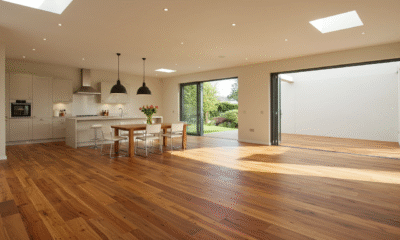

Features
The Top 7 Design Trends for Eco-Friendly Homes in 2016
With growing concern for the environment, green living initiatives are popping up in just about every aspect of life. From recycling to making conscious decisions about the things we buy and the resources we use, there are now a million ways for the average person to live an environmentally-friendly lifestyle.
If you’re in the market for a new home, you’ll be happy to learn that there are several green options for new home construction too. As you make important choices regarding materials, design and new home communities, don’t forget that you can also go green with these eco-friendly design trends.
Green Home Certification
Green home certification is a way to get a stamp of approval on your environmentally-friendly new home design. The most well-known certification is called LEED, which measures the home on categories such as energy and atmosphere, water efficiency, and materials and resources. There are also other green home certification programs, including NAHB Model Green Home Building Standard, Energy Star, as well as several state and local programs.
Green home certification is a badge of honor that says your home meets strict environmental standards. It can also improve home value when it comes time to sell. Even if you don’t go through the full certification, you can and should explore the certification programs in order to get green construction ideas for your new home and to facilitate communication with your home builder.
Energy Efficient Features
There are several opportunities in new home construction today where you can choose the energy efficient model to go green. Energy efficient choices can includes windows, appliances and also water efficiency features like low-flow faucets. By choosing an energy efficient model, you will consume less energy and therefore have a smaller footprint, but an added benefit is long-term savings for your wallet as well.
Net Zero Energy Homes
Choosing energy efficient features is the first step in lowering your energy consumption, but some home builders can take it a step further and help you create a net zero energy home. Net zero energy means that the amount of energy you consume is equal or less than the amount of energy you create. A net zero energy home is created by reducing energy consumption as much as possible (through energy efficient options, insulation, etc.) then adding renewable energy sources on your property, such as solar panels.
Locally Sourced Materials
Using local materials has always been trendy and a great way to support your local community. However, locally sourced materials are also an eco-friendly choice because they cut down on energy use and emissions from having materials shipped from further distances. When choosing materials, you can make a sustainable decision by going local.
Use Low VOC Coatings
VOC stands for volatile organic compounds, which are hazardous carbon-based chemicals that evaporate easily. Although VOCs are found in many things, they are relevant to new home construction because they are found in paints, stains, finishes, and other decorative coatings used inside and outside of the home.
VOCs are harmful to your health and can lead to a wide range of problems from nausea and dizziness to organ damage. They also evaporate into the atmosphere and contribute to pollution. Fortunately, you can cut back on your carbon footprint by using low and no VOC paint alternatives.
Greywater Reuse
Greywater refers to lightly used water from the home, such as the water that typically washes down the drain in sinks, showers, tubs and washing machines. Although this water may have traces of dirt, food and other products, it is still safe to use for some applications – particularly for outdoor irrigation. To incorporate greywater reuse into your new home construction, your new home builder can install pipes that channel this water outside where it can be used to water and fertilize your lawn and garden.
Energy Efficient Lightbulbs
We end the list with an eco-friendly trend that is within everyone’s means for old or new homes – choosing CFL or LED lightbulbs over traditional incandescent lightbulbs. Energy.gov states that CFL and LED bulbs use between 25 to 80 percent less energy, and they can last 3 to 25 times longer. This makes them a very environmentally-friendly and economical choice.
As you can see, there are many eco-friendly choices that you can make on new home construction, ranging from simple to elaborate. Custom home builders, such as Princeton Classic Homes, are always eager to incorporate your ideas into the design of your new home, including eco-friendly trends. So, the next time you build, consider these seven great eco-friendly design trends to help preserve the natural beauty that surrounds us.


 Environment9 months ago
Environment9 months agoAre Polymer Banknotes: an Eco-Friendly Trend or a Groundswell?

 Environment11 months ago
Environment11 months agoEco-Friendly Home Improvements: Top 7 Upgrades for 2025

 Features8 months ago
Features8 months agoEco-Friendly Cryptocurrencies: Sustainable Investment Choices

 Features9 months ago
Features9 months agoEco-Friendly Crypto Traders Must Find the Right Exchange



























